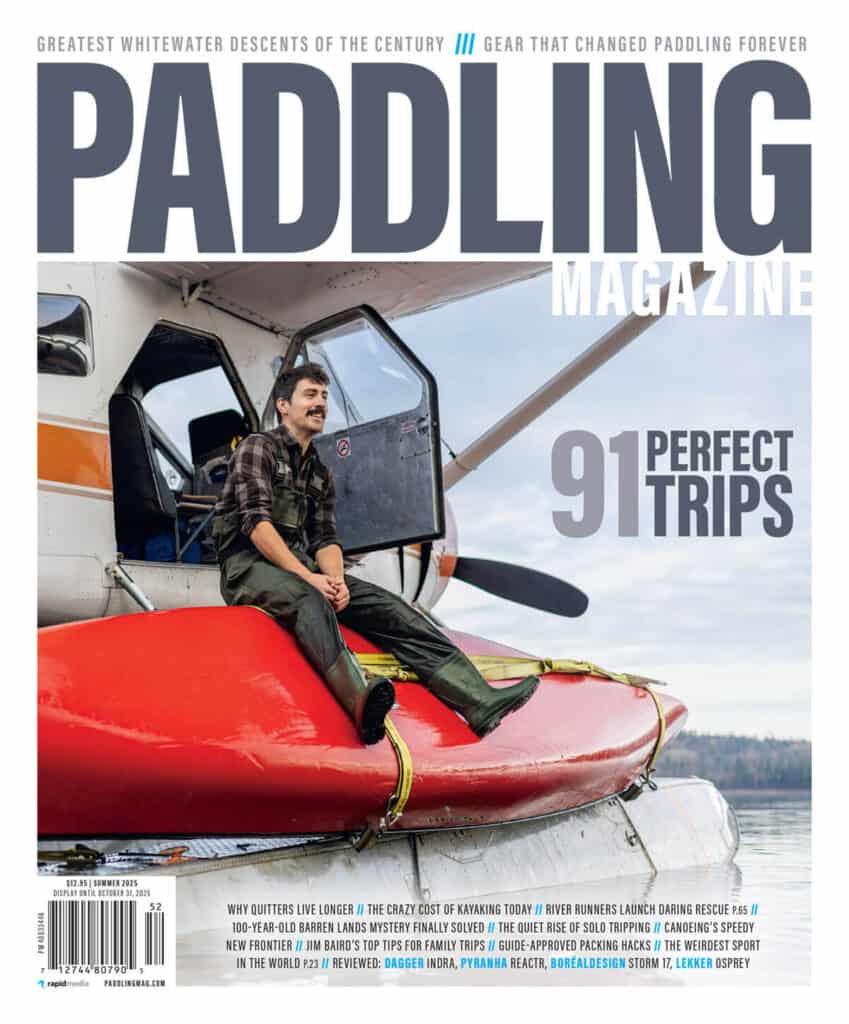When a husband-and-wife paddling team set out on a 1,000-mile, 64-day unsupported canoe trip through Canada’s northern Barren Lands to solve a century-old mystery, they knew success would be like finding a needle in a haystack.
One hundred years prior, John “Hermit of the North” Hornby and British financier John Critchell Bullock set out on a bold expedition. Their goal was to paddle into the Barren Lands and capture the first motion picture footage of muskoxen, believed to be extinct back then.
By the expedition’s second summer in 1925, their trip had turned into a fight for survival. The men were exhausted, starving and still 500 kilometers from the nearest outpost. In desperation, they decided to lighten their load.
“On a small island in the middle of the Hanbury River, we dumped 10,000 feet of unused motion picture film and a £1,000 movie camera,” Bullock wrote. “We were too starved to carry it.” He snapped a photo of the cache: a mound of rocks against a barren landscape.
Then his journal disappeared for 85 years.

100-year-old Barren Lands canoe expedition mystery solved
In 2015, a school clerk in England found Bullock’s writings tucked in a drawer. Two years later, they were published in the book Letters from the Barren Lands.
“For us, it was a fantastic Indiana Jones puzzle to solve after 100 years,” says Polish paddler Michal Lukaszewicz. He and his wife, Karolina Gawonicz, were captivated by the idea of finding the cache. “We thought, how hard could it be?”
The couple pored over Bullock’s journals, satellite imagery and maps. They cross-referenced their research with other canoeists who had paddled the same route. One location emerged as the cache’s most likely hiding spot.
In 2023, Michal and Karolina launched their expedition to unearth the cache: a two-month-long self-supported canoe trip from Yellowknife to Baker Lake, following Hornby and Bullock’s path through the tundra.
“It was amazing but punishing as well,” Michal said. “When we read Bullock’s letters, we felt his pain and dilemmas. And when we traveled through the Barren Lands, we experienced them firsthand.”
On day 42, the couple reached Grove Rapids on the Hanbury River, the suspected cache site. Most paddlers portage past this area, which could explain why the cache had remained undiscovered. They climbed to the highest point for a panoramic view and scanned the landscape.

What would not have changed in 100 years? In the blurred background of the photo, they noticed a cube-shaped erratic boulder. Behind it, a small lake matched Bullock’s photograph.
“When I looked through my binoculars, I saw this massive cube-shaped erratic boulder,” says Michal. “I thought, come on, this is probably it.”
Thirty minutes later: “There it was. A mound of boulders human hands hadn’t touched since Bullock and Hornby laid it down,” says Michal. “The entire scene matched Bullock’s photograph 99 percent—we felt chills rushing down our spines.”
Beneath the boulders, they found rusted metal, a piece of wood and the lid of a film canister; proof this was the cache Hornby and Bullock had built a century earlier. But the camera was gone.
Hornby had returned to the region with two companions on a famously ill-fated journey (all three died of starvation on the Thelon River in 1927). Michal and Karolina now believe Hornby retrieved the camera during that trip, likely hoping to sell it.
Though disappointed the camera was missing, Michal and Karolina say the real reward was the connection they felt across time, terrain and human experience. “By reaching the cache site, we felt that strong connection with Bollock and Hornby through the land,” says Michal.
Dubbed the Barren Lands by early European explorers, the treeless region is rich with wildlife and has sustained Indigenous communities for thousands of years. | Feature photo: Michal Lukaszewicz



 This article was published in Issue 74 of Paddling Magazine.
This article was published in Issue 74 of Paddling Magazine. 




